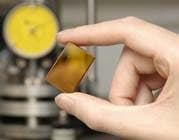Chalcogenide optical fiber from ORC could be basis for optical neural-network 'brain'
Unlike ordinary digital computers, the brain does its computing using neural networks made of axons and synapses -- an approach that is being imitated these days by researchers via software or electonic hardware, in attempts to create a device more capable and flexible than today's computers, capable of evolving thought. Now, a photonic version of axons and synapses has been demonstrated at the Optoelectronics Research Centre (ORC) at the University of Southampton (Southampton, England) and Nanyang Technological University (NTU; Singapore); the potential payoff is an energy-efficient brainlike computing system that operates at photonic speeds, which are vastly greater than electronic speeds.1
The researchers used optical microfibers made of light-sensitive metal-sulphide (chalcogenide) glass to show that neural networks and synapses in the brain can be reproduced, with optical pulses as information carriers.
In the last decade, neuromorphic computing research has advanced software and electronic hardware that mimic brain functions and signal protocols, aimed at improving the efficiency and adaptability of conventional computers. However, compared to our biological systems, today's computers are more than a million times less efficient. Simulating five seconds of brain activity takes 500 seconds while using 1.4 MW of power, compared to the small number of calories burned by the human brain.
Photoinduced signal switching
Using conventional fiber-drawing techniques, microfibers can be produced from chalcogenide that possess a variety of broadband photoinduced effects, which allow the fibers to be switched on and off. This optical switching can be exploited for a variety of next-generation computing applications capable of processing vast amounts of data in a much more energy-efficient manner.
The team demonstrated a range of optical equivalents of brain functions, including holding a neural resting state and simulating the changes in electrical activity in a nerve cell as it is stimulated. In the proposed optical version of this brain function, the changing properties of the glass act as the varying electrical activity in a nerve cell, and light provides the stimulus to change these properties. This enables switching of a light signal, which is the equivalent to a nerve cell firing.
"This work implies that 'cognitive' photonic devices and networks can be effectively used to develop non-Boolean computing and decision-making paradigms that mimic brain functionalities and signal protocols, to overcome bandwidth and power bottlenecks of traditional data processing," says Cesare Soci, one of the NTU researchers.
Source: http://www.southampton.ac.uk/mediacentre/news/2015/mar/15_45.shtml#.VP8JIKbHlTY
REFERENCE:
1. Behrad Gholipour et al., Advanced Optical Materials; DOI: 10.1002/adom.201400472

John Wallace | Senior Technical Editor (1998-2022)
John Wallace was with Laser Focus World for nearly 25 years, retiring in late June 2022. He obtained a bachelor's degree in mechanical engineering and physics at Rutgers University and a master's in optical engineering at the University of Rochester. Before becoming an editor, John worked as an engineer at RCA, Exxon, Eastman Kodak, and GCA Corporation.
